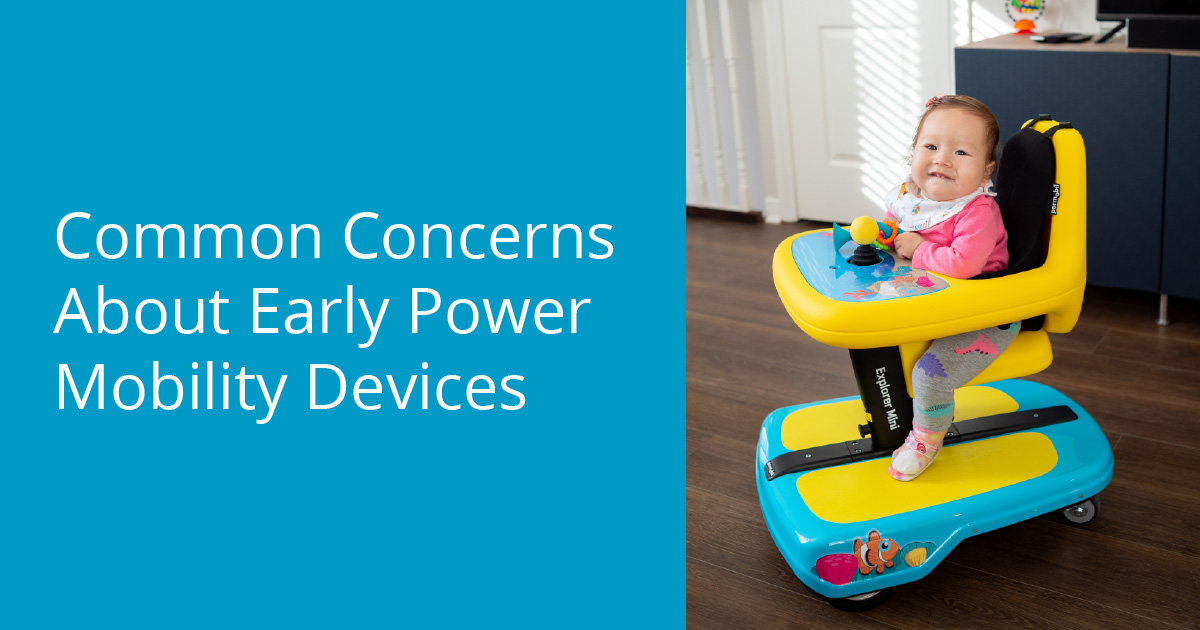The last part in our series about developmental milestones in early childhood focusing on mobility. See part 1, part 2, part 3, part 4, part 5, part 6, part 7, part 8, part 9, part 10, part 11, and part 12. Learn more about the Explorer Mini here.
Perhaps one of the mostly widely known authors on this topic are Wiart and Darrah from an article published in 2002 entitled “Changing philosophical perspectives on the management of children with physical disabilities: Their effect on the use of powered mobility.” The authors highlight the paradigm shift that occurred around that time frame and that several factors contributed to the new philosophy.
Two very important political changes occurred
1. Change the languageIn 2001 the World Health Organization (WHO) changed the language associated with people with illnesses or conditions. Before this, terms such as handicapped, disabled, or abnormal were used to describe people. This language attributed the physical condition as something “wrong with the person”. Additionally, passing of the Americans with Disabilities Act (ADA) in 1990 contributed to the conversation of how to characterize disabilities. The ADA admitted that the concern was with the environment. If ramps were used instead of stairs the person using a wheelchair could “participate” in activities of their choice.
2. Providing accessIn conjunction, the new WHO model; the International Classification of Functioning, Disability and Health (ICF) describes functioning using two components:
- Body structure and function, and
- Activities and participation.
Taken together they ascribe that a person may have a disability but it is the lack of access (stairs in this example) that “handicap” the person. Therefore, changing the environment allows access to the environment.
So, what does this have to do with wheelchairs? According to the ICF a wheelchair is part of the environment. The reason infants and young children have difficulty with environmental exploration is because there has not been a suitable wheeled mobility device for many young children with disabilities until the Explorer Mini by Permobil was developed.
The Importance of Perception
Caregivers, and clinicians have been reluctant to recommend or accept a wheelchair as it may be seen as a “last resort”, a failure, a sign of a disability (2). In fact, the disability is not having access to one’s environment! This is particularly troubling for infants who need environmental exploration to learn, play, socialize and find who they are in their world. Not having access to a properly fitted mobility device is the handicap.
Six mothers participated in an in-depth interview regarding the use of power mobility (2). In this study, all mothers stated that their child demonstrated increased independence and personal control. Further stating that the increase in independence enabled their children to engage in meaningful life experiences (2). Finally, the mothers in this study also noted that peers and strangers reacted positively to the child, seeing the child rather than a device and realizing that the child was more capable than what the person expected. The child’s ability to engage with other children allowed the child to develop friendships and be involved in activities at their age level.
Where we are today with early mobility devices
Nearly 2 decades have passed since this new paradigm shift has occurred so why have we not adequately addressed the needs of infants and young children. Why might we still be resistant to accepting a new mobility device for infants and young children. I would ask you to consider this: the evidence clearly demonstrates that the ability to access one’s environment allows one to participate in life events. For infants, it contributes to learning and growing. Perhaps in the next few years we will have your stories of how mobility changed your child and your family.
1.Wiart, L. & Darrah, J. (2002) Changing philosophical perspectives on the management of children with physical disabilities: Their effect on the use of powered mobility. Disability and Rehabilitation, Vol 24. No.9, 492-498.
2.Wiart, L., Darrah, J., Hollis, V., Cook, A., & May, L. (2004). Mothers’ perceptions of their children’s use of powered mobility. Physical and Occupational Therapy in Pediatrics, Vol 24 (4). Doi:10.1300/J006v24n04_02
3.World Health Organization ICF. International Classification of Functioning, Disability and Health. Geneva: World Health Organization, 2001
 Dr Teresa Plummer, PhD, OTR/L, ATP, CEAS, CAPS
Dr Teresa Plummer, PhD, OTR/L, ATP, CEAS, CAPS
Associate Professor in the School of Occupational Therapy at Belmont University
Dr Teresa Plummer, PhD, OTR/L, ATP, CEAS, CAPS is an Associate Professor in the School of Occupational Therapy at Belmont University in Nashville, TN. She has over 40 yrs of OT experience and 20 in the area of Assistive Technology. She is a member of the International Society of Wheelchair Providers, and the Clinicians Task Force. She is a reviewer for American Journal of OT and guest reviewer for many other journals. She has presented internationally, nationally and regionally particularly in the area of pediatric power mobility. She has authored journal articles and textbook chapters in the area of OT and pediatric mobility and access.

